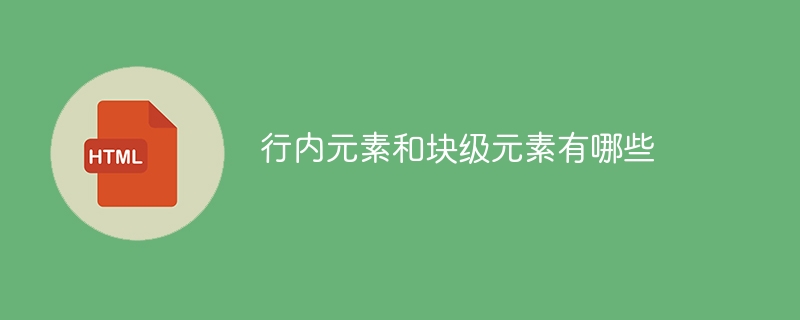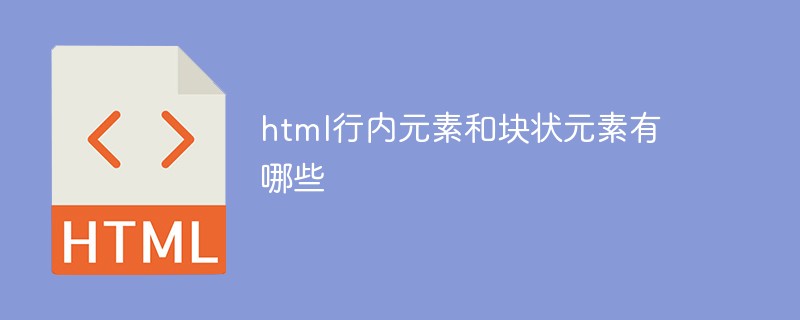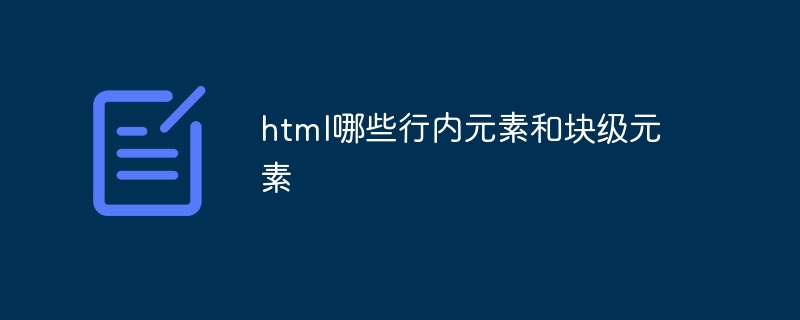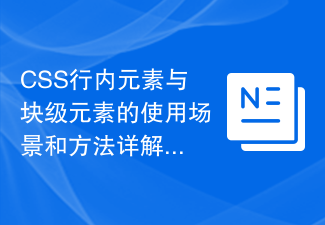 Web Front-end
Web Front-end HTML Tutorial
HTML Tutorial The difference between inline elements and block-level elements: an in-depth understanding of element classification in HTML
The difference between inline elements and block-level elements: an in-depth understanding of element classification in HTML
The difference between inline elements and block-level elements: an in-depth understanding of the classification of elements in HTML
In HTML, elements can be divided into two categories: inline elements and block-level elements. . Understanding their differences is very important to correctly master the layout and style of HTML. This article will provide an in-depth understanding of the characteristics of inline elements and block-level elements, and provide specific code examples.
- Inline elements
Inline elements refer to elements that are displayed inline by default in HTML documents. They do not occupy an entire row, but appear closely within a row based on how the document flow is arranged. Common inline elements include , , , , etc.
The characteristics of inline elements are as follows:
(1) They will not occupy a single line, but are closely arranged from left to right;
(2) There is no width and height setting Options, the width and height are determined by the content;
(3) You cannot set the top and bottom margins (margin-top, margin-bottom), top and bottom padding (padding-top, padding-bottom);
(4 ) You can set left and right margins and left and right padding;
(5) It cannot contain block-level elements, but can only contain inline elements or text.
The following is a specific code example that demonstrates the characteristics of inline elements:
<span style="border: 1px solid black; padding: 5px;">这是一个行内元素</span> <span style="border: 1px solid black; padding: 5px;">这是另一个行内元素</span>
Run the above code in the browser, you can see that two inline elements are closely arranged in one line, and Width and height automatically adapt to the size of the content.
- Block-level elements
Block-level elements refer to elements that are displayed in block-level mode by default in HTML documents. They occupy an entire line, and each block-level element wraps to another line. Common block-level elements include
,
~, etc.
The characteristics of block-level elements are as follows:
(1) It occupies a whole line, and each block-level element will be displayed in a new line;
(2) The width and height can be set;
(3) You can set top and bottom margins, top and bottom margins;
(4) You can include inline elements, block-level elements or text.
The following is a specific code example that demonstrates the characteristics of block-level elements:
<div style="border: 1px solid black; padding: 5px;">
<p>这是一个块级元素</p>
<p>这是另一个块级元素</p>
</div>Run the above code in the browser, you can see that two block-level elements occupy one line and have the same width. and height can be set via CSS styles.
Summary:
The classification of inline elements and block-level elements in HTML is based on how they are displayed. Inline elements are tightly arranged in rows and will not occupy an entire row, while block-level elements occupy an entire row, and each block-level element will be displayed on a new line. We can choose to use inline elements or block-level elements according to actual needs, and combine them with CSS styles to achieve various complex layout and style effects.
The above is the detailed content of The difference between inline elements and block-level elements: an in-depth understanding of element classification in HTML. For more information, please follow other related articles on the PHP Chinese website!
 行内元素和块级元素有哪些Aug 17, 2023 am 11:33 AM
行内元素和块级元素有哪些Aug 17, 2023 am 11:33 AM行内元素有div、p、h1-h6、ul、ol、li、table、form等;块级元素有span、a、img、strong、em、input、label等。两种元素的特点:1、行内元素,会独占一行,自动填充父容器的宽度,可以设置宽度、高度、内外边距等属性,可以包含其他块级元素和行内元素;2、行内元素,不会独占一行,宽度和高度由内容决定,内外边距只影响元素自身的排列等等。
 html行内元素和块状元素有哪些Feb 20, 2021 pm 04:03 PM
html行内元素和块状元素有哪些Feb 20, 2021 pm 04:03 PMhtml行内元素有:a(锚点元素)、b(粗体)、br(换行)、code、em(强调)、font(字体设置)、i(斜体)、img(图片)、input(输入框)、span、strong(粗体强调)、textarea、u等;块状元素有:address(地址)、blockquote(块引用)、center(居中对齐块)、div、h1~h6(标题)、hr(水平分隔线)、p、ul、ol等。
 行内元素与块级元素的区别:深入理解HTML中的元素分类Dec 23, 2023 am 10:01 AM
行内元素与块级元素的区别:深入理解HTML中的元素分类Dec 23, 2023 am 10:01 AM行内元素与块级元素的区别:深入理解HTML中的元素分类在HTML中,元素可以分为行内元素和块级元素两类。了解它们的区别对于正确掌握HTML的布局和样式是非常重要的。本文将深入理解行内元素和块级元素的特点,并提供具体的代码示例。行内元素行内元素是指在HTML文档中默认以行内方式显示的元素。它们不会独占一整行,而是根据文档流的排列方式在一行内紧密显示。常见的行内
 行内元素和块级元素之间的区别有哪些Oct 16, 2023 am 09:51 AM
行内元素和块级元素之间的区别有哪些Oct 16, 2023 am 09:51 AM行内元素和块级元素的区别有“盒模型”、“排列方式”、“内容显示”、“相对位置”和“默认尺寸”五种区别:1、行内元素不产生独立的框,宽度和高度由内容决定,而块级元素会生成一个独立的矩形框,可以设置宽度、高度、边距和填充等属性;2、行内元素在同一行上水平排列,而块级元素会自上而下按顺序排列;3、行内元素不能包含块级元素,而块级元素可以包含其他块级元素和行内元素等。
 html哪些行内元素和块级元素Oct 16, 2023 am 09:57 AM
html哪些行内元素和块级元素Oct 16, 2023 am 09:57 AMhtml常用的行内元素和块级元素有:1、块级元素包括<div>、<p>、<ul>和<ol>、<li>、<h1>~<h6>和<header>等语义化标签;2、行内元素包括<span>、<a>、<strong> 和 <em>、<img>和<input>等标签。
 CSS行内元素与块级元素的使用场景和方法详解Dec 23, 2023 pm 02:19 PM
CSS行内元素与块级元素的使用场景和方法详解Dec 23, 2023 pm 02:19 PMCSS行内元素和块级元素详解:探索它们的应用场景和使用方法在CSS中,元素可以根据其显示特性分为两种类型:行内元素和块级元素。对于网页开发者来说,理解这两个概念非常重要,因为它们的不同特性决定了它们的应用场景和使用方法。行内元素行内元素是指在网页中只占据一行的元素。常见的行内元素有、、、
 HTML5行内元素和块级元素的简介与区别Dec 28, 2023 pm 02:57 PM
HTML5行内元素和块级元素的简介与区别Dec 28, 2023 pm 02:57 PMHTML5行内元素和块级元素简介及区别HTML5是一种用于创建网页结构的标记语言。在HTML5中,元素被分为两种类型:行内元素(inlineelements)和块级元素(blockelements)。行内元素简介:行内元素是指在文档流中显示为一行的元素。它们只占据自身内容的空间,并且不会破坏页面的整体布局。行内元素可以包含文本、其他行内元素或部分块级元素
 行内元素和块级元素的区别有什么Aug 18, 2023 pm 05:02 PM
行内元素和块级元素的区别有什么Aug 18, 2023 pm 05:02 PM行内元素和块级元素的区别有:1、行内元素不会独占一行,而块级元素会独占一行;2、行内元素的宽度由其内容决定,而块级元素的宽度默认是其父元素的100%;3、行内元素的盒模型主要包括水平方向的内边距、外边距和边框,而每个方向都有。


Hot AI Tools

Undresser.AI Undress
AI-powered app for creating realistic nude photos

AI Clothes Remover
Online AI tool for removing clothes from photos.

Undress AI Tool
Undress images for free

Clothoff.io
AI clothes remover

AI Hentai Generator
Generate AI Hentai for free.

Hot Article

Hot Tools

SublimeText3 Mac version
God-level code editing software (SublimeText3)

Dreamweaver Mac version
Visual web development tools

SublimeText3 Chinese version
Chinese version, very easy to use

VSCode Windows 64-bit Download
A free and powerful IDE editor launched by Microsoft

SublimeText3 Linux new version
SublimeText3 Linux latest version






